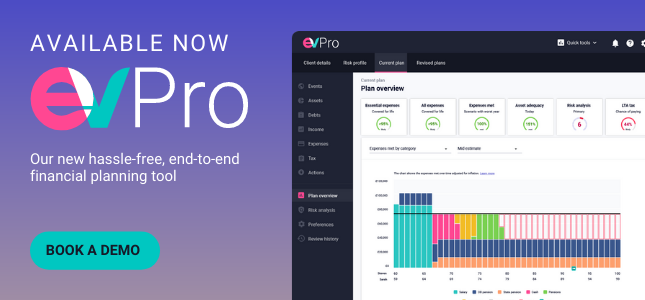Consumer Duty: The vital role cashflow planning has to play
.png)
In this blog, we explore how cashflow planning tools can enhance the client-adviser relationship and ensure compliance with the Financial Conduct Authority’s (FCA) latest Consumer Duty rules.
When the FCA implemented their Consumer Duty legislation, they emphasised advisory firms' need to prioritise client needs to ensure positive financial outcomes. The aim was to set higher and clearer consumer protection standards across financial services.
But with no prescribed method of achieving this, it’s very much down to individual adviser firms to devise a way that works for them and their advisers, ensuring they can deliver on their obligations and put the client first.
Adopting the right cashflow forecasting technology is one-way financial advisers can address this challenge. Using tools for lifetime cashflow forecasts to comprehensively plan their clients' long-term financial outlooks can lead to better financial outcomes and an engaging client experience.
Integrating cashflow planning into the advisory process is an essential tool that aligns with regulatory requirements and significantly enhances the client-adviser relationship.
Benefits of cashflow planning
The use of these cashflow planning tools helps advisers:
- Identify potential gaps or risks in their clients' financial plans, enabling them to suggest suitable products or strategies to mitigate these concerns.
- Stress test financial plans for unforeseen events or plan for one-off events in the future.
- Deliver transparent documentation of their advice and the reasoning behind any product recommendations. This documentation proves valuable for firms in showcasing adherence to the new Consumer Duty rules and providing evidence to the FCA.
The power of visualisation
As the saying goes, a picture paints a thousand words. This adage is never more true for advisers communicating complex financial information to their clients. In financial advice, lifetime cashflow planning tools serve as visual aids, creating detailed projections of a client's financial situation over the long term. Clients can find confidence and understanding in graphical representations.
Cashflow planning tools consider various factors, including income, assets, liabilities, inflation, and market performance. By visually presenting this information, advisers empower their clients to grasp complex financial scenarios easily. This deepens client understanding and encourages meaningful discussions between clients and advisers, aligning with the objective of the Consumer Duty, which prioritises clients' needs.
Financial guidance that stands the test of time
Cashflow planning is a dynamic tool that evolves with the client's journey through key life milestones. Whether it's retirement planning, estate planning, or investment planning, the automated calculations based on real-time data offer ongoing insights. This iterative process proves invaluable, especially during pivotal life events like retirement or significant financial investments.
Technology is a catalyst for better outcomes
Technology has revolutionised cashflow planning, making it more efficient and accurate. Standardised reports based on realistic forecasting calculations and proven assumptions provide a reliable foundation for financial projections.
Integrating various adviser tools, i.e. risk profiling, investment suitability, and cashflow planning, further contributes to consumer understanding by offering insights into effective communication strategies tailored to different client segments. These systems ensure that clients receive and comprehend information, promoting transparency and compliance with Consumer Duty regulations.
Overcoming potential challenges with cashflow planning software
Cashflow planning is a transformative tool. Here are some of the challenges it can help you overcome:
Time Constraints: Cashflow software alleviates the time spent working on problem-solving by providing advisers with the ability to stress test a variety of financial challenges. Functionality such as “stress testing” effectively gauges how financial plans will fare in various market scenarios and how these scenarios will affect a client’s overall financial goals—saving advisers several hours of work and helping the client better understand their plans
Information Overload: Often, clients can be overwhelmed with too much information that is hard to digest. Cashflow software simplifies complex information through user-friendly visualisations, ensuring clients can easily interpret and understand their financial plans.
Explaining Assumptions: Communicating assumptions is crucial. Cashflow software can give a simple forecast and consider market changes by running a thousand scenarios each year to ensure clients' expectations can be managed around the uncertainties they are likely to experience.
Cost of Delivery: Cashflow software proves effective for clients across various financial planning areas. By quickly demonstrating the effectiveness of a financial plan, advisers can offer streamlined services to clients with varying budgets, ensuring that even those with limited resources benefit from sound financial planning.
Conclusion
In conclusion, cashflow planning tools are not only there to assist with compliance requirements but can be a core part of an adviser's armoury to enhance the client-adviser relationship. By adopting these tools as part of the advice process, advisers can align with Consumer Duty rules and provide clients with a clear roadmap for their financial future.
Embracing the right technology transforms this process from a time-consuming, administrative heavy task to a dynamic, interactive experience that promotes financial well-being for clients and strengthens the foundation of trust between advisers and consumers—ultimately leads to better consumer financial outcomes, which is the FCA’s mantra and something as an industry we need to embrace.
So what next?
